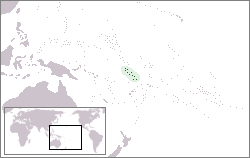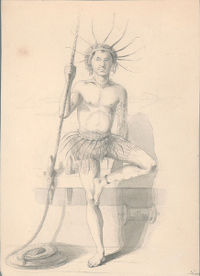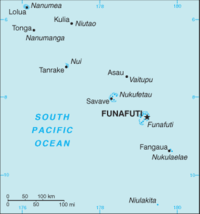Tuvalu
2007 Schools Wikipedia Selection. Related subjects: Countries; Geography of Oceania (Australasia)
| Tuvalu | |||||
|
|||||
| Motto: Tuvalu mo te Atua (English: "Tuvalu for the Almighty") |
|||||
| Anthem: Tuvalu mo te Atua (English: "Tuvalu for the Almighty") Royal anthem: God Save the Queen |
|||||
| Capital |
Vaiaku (village; Gov.), Fongafale (islet), Funafuti (atoll) |
||||
|---|---|---|---|---|---|
| Official languages | Tuvaluan, English | ||||
| Government | Constitutional monarchy | ||||
| - Queen | Elizabeth II | ||||
| - Governor | Filoimea Telito | ||||
| - Prime Minister | Apisai Ielemia | ||||
| Autonomy | |||||
| - from the UK | 1 October 1978 | ||||
| Area | |||||
| - Total | 26 km² ( 227th) 10 sq mi |
||||
| - Water (%) | negligible | ||||
| Population | |||||
| - July 2005 estimate | 10,441 ( 222nd) | ||||
| - Density | 441/km² ( 22nd) 1,142/sq mi |
||||
| GDP ( PPP) | 2001 estimate | ||||
| - Total | $12.2 million ( 228th) | ||||
| - Per capita | $1,100 (2000 est.) ( unranked) | ||||
| HDI (2003) | n/a (unranked) ( n/a) | ||||
| Currency | Tuvaluan dollar Australian dollar ( AUD) |
||||
| Time zone | ( UTC+12) | ||||
| Internet TLD | .tv | ||||
| Calling code | +688 | ||||
Tuvalu, formerly known as the Ellice Islands, is a Polynesian island nation located in the Pacific Ocean midway between Hawaii and Australia. Its nearest neighbours are Kiribati, Samoa and Fiji. Comprising 4 reef islands and 5 true atolls, with a total land area of just 26 square kilometers (10 sq mi), it is the second-least populated independent country in the world, Vatican City being the smallest. It is the smallest member by population of the United Nations.
The first inhabitants of Tuvalu were Polynesian people. The islands came under Britain's sphere of influence in the late 19th century. The Ellice Islands were administered by Britain as part of a protectorate from 1892 to 1916 and as part of the Gilbert and Ellice Islands Colony from 1916 to 1974. In 1974 the Ellice Islanders voted for separate British dependency status as Tuvalu, separating from the Gilbert Islands which became Kiribati upon independence. Tuvalu became fully independent in 1978.
Due to their low elevation, the islands that make up this nation are threatened by any future sea level rise. The population may evacuate during the next decades to New Zealand, Niue or the Fijian island of Kioa.
History
Tuvaluans are a Polynesian people who settled the islands around 2000 years ago coming from Tonga and Samoa. During pre-contact times, there was frequent canoe voyaging between the nearer islands. 8 of the 9 islands of Tuvalu were inhabited, thus, the name Tuvalu means "eight standing together" in the Tuvaluan language.
Tuvalu was first sighted by Europeans in 1568 with the arrival of Alvaro de Mendaña y Neyra from Spain, who encountered the island of Nui but was unable to land. No other Europeans turned up again until the late 1700s, when further European explorers reached the area. By the early 1800s, whalers were in the Pacific, though visiting Tuvalu only infrequently due to the difficulties of landing ships on the atoll, and no settlements were established by them. Peruvian slave raiders (" blackbirders") combed the Pacific between 1862 and 1864 and Tuvalu was one of the hardest hit Pacific island groups with over 400 people taken from Funafuti and Nukulaelae, none of whom returned. In 1865, the London Missionary Society, Protestant congregationalists, began their process of evangelization of Tuvalu, and conversion to Christianity was complete by the 1920s. Also in the late 1800s, European traders began to live on the islands hoping to profit from local resources.
In 1892, the islands became part of the British protectorate known as the Ellice Islands. The protectorate was incorporated into the Gilbert and Ellice Islands Colony in 1916. In 1943 during World War II, Tuvalu was selected as an operations base for Allied forces battling Japanese in the Pacific. Thousands of marines were stationed there until December 1945. In 1974, ethnic differences within the colony caused the Polynesians of the Ellice Islands to vote for separation from the Micronesians of the Gilbert Islands (later Kiribati). The following year, the Ellice Islands became the separate British colony of Tuvalu. Independence was granted in 1978. Tuvalu Independence Day is celebrated on October 1st. In 1979 Tuvalu signed a treaty of friendship with the United States, which recognized Tuvalu's possession of four small islands formerly claimed by the United States.
As low lying islands lacking a surrounding shallow shelf, the island communities of Tuvalu are especially susceptible to changes in sea level and storm patterns that hit the island undissipated. The extent and causes of sea level change are disputed, however it is estimated that a sea level rise of 20-40 centimetres (8-16 in) in the next 100 years could make Tuvalu uninhabitable. The South Pacific Applied Geoscience Commission suggest that while Tuvalu is vulnerable to climate change, there are additional environmental problems such as population growth and poor coastal management, which are affecting sustainable development on the island, they rank the country as extremely vulnerable using the Environmental Vulnerability Index. While some commentators have called for the relocation of the population of Tuvalu to Australia, New Zealand or Kioa (Fiji), the current Prime Minister Maatia Toafa says his government does not regard rising sea levels as such a threat that the entire population would need to be evacuated. New Zealand has agreed to accept an annual quota of 75 evacuees.
Politics
Tuvalu is a constitutional monarchy and Commonwealth Realm, with Queen Elizabeth II recognised as Queen of Tuvalu. She is represented in Tuvalu by a Governor-General, who is appointed upon the advice of the Prime Minister. The local unicameral parliament, or Fale I Fono, has 15 members and is elected every four years. Its members elect a Prime Minister who is the head of government. The Cabinet is appointed by the Governor General on the advice of the Prime Minister. Some elders also exercise informal authority on a local level. There are no formal political parties and election campaigns are largely on the basis of personal/family ties and reputation.
The highest court in Tuvalu is the High Court, there are eight Island Courts with limited jurisdiction. Rulings from the High Court can be appealed to the Court of Appeal in Fiji.
Tuvalu has no regular military forces, and spends no money on the military. Its police force includes a Maritime Surveillance Unit for search and rescue missions and surveillance operations. The police have a Pacific-class patrol boat (Te Mataili) provided by Australia under the Pacific Patrol Boat Program for use in maritime surveillance and fishery patrol.
Districts
Tuvalu's small population is distributed across 9 islands, 5 of which are atolls. The smallest island, Niulakita, was uninhabited until it was resettled by people from Niutao in 1949.
Local government districts consisting of more than one island:
- Funafuti
- Nanumea
- Nui
- Nukufetau
- Nukulaelae
- Vaitupu
Local government districts consisting of only one island:
- Nanumaga
- Niulakita
- Niutao
Foreign relations
Tuvalu maintains close relations with Fiji and Australia. It has diplomatic relations with the Republic of China (Taiwan); Taipei maintains the only resident embassy in Tuvalu and has a large assistance program in the islands.
Tuvalu became a member of United Nations in 2000 and maintains a mission at the UN in New York. A major international priority for Tuvalu in the UN, at the World Summit on Sustainable Development in Johannesburg and in other international fora is promoting concern about global warming and possible sea level rise. Tuvalu advocates ratification and implementation of the Kyoto Protocol. It also is a member of the Asian Development Bank.
Tuvalu is a party to a treaty of friendship with the United States, signed soon after independence and ratified by the U.S. Senate in 1983, under which the United States renounced prior territorial claims to four Tuvaluan islands under the Guano Act.
Geography
Tuvalu consists of four reef islands and five true atolls. Its small, scattered group of atolls has poor soil and a total land area of only about 26 square kilometres (less than 10 sq. mi.) making it the fourth smallest country in the world. The land is very low lying with narrow coral atolls. The highest elevation is five meters (16 ft) above the sea level. Funafuti is the largest atoll of the nine low reef islands and atolls that form the Tuvalu volcanic island chain. It comprises numerous islets around a central lagoon that is approximately 25.1 kilometres (15.6 mi) (N-S) by 18.4 kilometres (11.4 mi) (W-E), centred on 179°7’E and 8°30’S. An annular reef rim surrounds the lagoon, with several natural reef channels.
Tuvalu has very poor land and the soil is hardly usable for agriculture There is almost no reliable supply of potable water.
Tuvalu has westerly gales and heavy rain from November to March and tropical temperatures moderated by easterly winds from March to November.
Economy
Tuvalu has almost no natural resources, and its main form of income consists of foreign aid. Virtually the only jobs in the islands that pay a steady wage or salary are with the government. Subsistence farming and fishing remain the primary economic activities, particularly off the capital island of Funafuti. Government revenues largely come from the sale of stamps and coins, fishing licences and worker remittances.
About 800 Tuvaluans work in Nauru in the phosphate mining industry or aboard foreign ships as sailors. Substantial income is received annually from an international trust fund established in 1987 by Australia, New Zealand, and the United Kingdom and supported also by Japan and South Korea. This fund grew from an initial $17 million to over $35 million in 1999. The US government is also a major revenue source for Tuvalu, with 1999 payments from a 1988 treaty on fisheries at about $9 million, a total which is expected to rise annually. In an effort to reduce its dependence on foreign aid, the government is pursuing public sector reforms, including privatization of some government functions and personnel cuts of up to 7%.
In 1998, Tuvalu began deriving revenue from use of its area code for "900" lines and from the sale of its " .tv" Internet domain name. In 2000, Tuvalu negotiated a contract leasing its Internet domain name " .tv" for $50 million in royalties. However, the Canadian entrepreneur who negotiated the deal, Jason Chapnik, was unable to raise the $50 million in the contracted time period, and the contract eventually fell into other hands.
Due to its remoteness, tourism does not provide much income; only a handful of tourists visit Tuvalu annually. Almost all visitors are government officials, aid workers, non-governmental organization officials or consultants.
Demographics
The island population has more than doubled since 1980 and was estimated to reach 11,810 in July 2006. The population of Tuvalu is primarily of Polynesian ethnicity, about 4% of the population in Micronesian. About 97% of the Tuvaluans are members of the Church of Tuvalu, a Protestant Christian church. The religion has been mixed with some elements of the indigenous religions. Other religions practiced on the island include Seventh-Day Adventist (1.4%) and Baha'i (1%).
The Tuvaluan language is spoken by virtually everyone, while Gilbertese is spoken by some people on Nui. English is also an official language, but is not spoken in daily use.
Culture
The traditional community system still to a large extent survives on Tuvalu. Each family has its own task, or salanga, to perform for the community, such as fishing, house building or defence. The skills of a family are passed on from father to son.
A traditional sport played in Tuvalu is kilikiti, which is similar to cricket.
Traditional music prior to European contact included poems performed in a sort of monotonal recitation, though this tradition has since become extinct , as well as work songs which the women performed to encourage the men while they worked.
The most famous form of Tuvaluan dance music, fatele, is influenced by European melody and harmony and is competitive, with each island divided into two sides .
The two primary traditional dances of Tuvalu are the fakanu and fakaseasea. Of these, the fakanu has since died out, though the fakaseasea lives on, performed only by elders .




